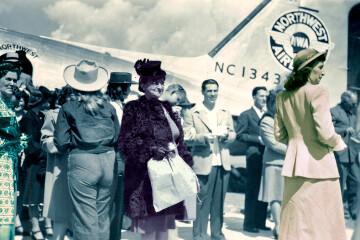Defining Nuisances: Bozeman’s 1883 City Ordinances

When the city of Bozeman incorporated on March 26, 1883, John V. Bogert was elected the city’s enthusiastic first mayor. The new city leader and his aldermen immediately began passing ordinances regulating everything from business signs to swearing in public places. Elected mayor for several terms, Bogert also initiated creation of a fire department and increased public health and safety standards. Many city ordinances adopted in the 1880s stemmed from an urgent need to establish law enforcement and to protect Bozeman citizens in areas of public health and safety. When viewed through a modern lens, some of these laws are amusing, but they all were meant to solve a historic problem.
Initially, the city was divided into four wards, each represented by two aldermen. An elected mayor served as chief executive. The First Ward was north of Main Street and east of Bozeman Avenue, the Second Ward was north of Main and west of Bozeman Avenue, the Third Ward was south of Main and west of Black Avenue, and the Fourth Ward was south of Main and east of Black Avenue. In 1883, polling places were open from one o’clock pm to six o’clock pm and election judges and clerks were paid $2 for their time (this would be about $53 today).
It is almost certain that Bozeman had a version of a police force before the city incorporated, but the very first chapter of the very first ordinance adopted by the city of Bozeman formally established the Bozeman Police Department. “The city council may appoint two policemen, who shall be night watchmen…and whose term of office shall be one year from the date of their appointment and qualification…” In addition, a city marshal position was created to oversee the night watchmen, run the jail and make arrests. A police magistrate was responsible for collecting fines and hearing and determining cases involving ordinance violations in a police court.
In April 1883, the city council formally hired Jacob Oakwood as city marshal and Joseph Didawick and George Herendeen as night watchmen under the new Police Department. Jacob Oakwood was a Swiss-born British citizen who immigrated to America and ended up in Montana in 1870. Oakwood served as city marshal for two years and was instrumental in getting the new Police Department up and running smoothly. Among other things, he dealt with horse racing on Main Street, seized opium pipes, ran the animal pound, and collected fines and license fees from occupants of the red light district.
In addition to defining roles of Police Department personnel, the first city ordinance also outlined the duties of other city officers like the attorney, assessor, street commissioner and clerk. The city attorney would prosecute violators of city ordinances and the assessor handled tax assessments and served as treasurer. A street commissioner was appointed to watch over streets, alleys and sidewalks, and to be responsible for their repair and construction. The city clerk archived municipal documents, recorded city council meeting minutes, and kept the city seal. The official seal for the city of Bozeman was adopted and approved on May 26, 1883. Ordinance 15 described the seal as having “…circular form, with the words ‘City of Bozeman, Gallatin Co., Montana,’ on the edge of said circle, and having in the center thereof a self-binding harvester and a prostrate sheaf, and underneath the date, ‘1883’…” This is the seal the city of Bozeman still uses today.
Besides law enforcement, a major concern of the newly incorporated city was public health and city cleanliness. Horses, cattle and chickens were kept by many residents throughout the town and were necessary for food and transportation. Among other things, Ordinance 5, adopted April 19, 1883, required citizens to keep corrals, barns, and animal shelters clean and in good order. “Any person who shall…keep or maintain any pen inclosure [sic], stable or building for cattle, horses or other animals, in such a filthy condition as to be offensive to neighbors or passers-by, or injurious to the health of the neighborhood, such person shall be deemed guilty of maintaining a nuisance…” Because animals and people lived in such close proximity, violations could be contentious issues.
In a world without electricity and plumbing, other public health concerns revolved around maintaining cellars and outhouses and keeping garbage, spoiled food and animal waste out of the street. While some of these city cleanliness rules seem dated to us today, many still ring true. Section 6 of Ordinance 5 states: “It shall be the duty of the occupant of any premises within the city limits to keep the sidewalk in front of and adjoining the premises so occupied, clean and safe for pedestrians, and such occupant shall with all reasonable dispatch remove snow, ice, slush, mud or other impediment to safe and convenient foot travel, and prevent the continuance and accumulation of the same.” Most of these “nuisance” violations came with a fine of between $1 and $20 ($26 - $530 today).
Ordinance 13, approved on May 15, 1883, called for the creation of a health officer position. The health officer’s primary duties at this time included inspecting food for sale in the city and working with the city marshal and police to enforce the sale of safe food and milk. The health officer received no pay. Marshal Oakwood himself was responsible for posting quarantine and health notice signs in public places throughout the city. It wasn’t until 1891 that the city council established a board of health and hired a paid physician as a health officer. The council gave the board of health and the health officer the power to close schools, quarantine the city and “…establish a pest house and provide for the maintenance of the same at the expense of the city.”
Perhaps the laws that seem most amusing to us today can be found in Ordinance 8, “Concerning Offenses Against Good Order and Morals.” While this section does cover familiar offenses like disturbing the peace, public intoxication and assault, it also includes laws that were more specific to frontier towns in the 1880s.
Planning or encouraging a dog or cock fight was a misdemeanor and carried a fine of $5 to $25 ($132 - $663 today). Opium addiction was certainly an issue in many frontier towns, and in Bozeman, it was a misdemeanor to use opium or to operate an opium den. Opium violations came with stiffer fines - $10 to $100 ($265 - $2,654 today).
Section 10 contains an 1883 version of today’s traffic laws. “If any person shall immoderately ride or drive any team or single animal through any of the streets of the city, or shall ride, lead or drive any horse, mule, ox or cow upon or along any of the sidewalks of the city, such person shall, on conviction, be fined not less than five dollars nor more than fifty dollars” ($132 - $1,327 today). Accidents involving horses and wagons were not an uncommon occurrence in early Bozeman, so the law further stated that all horses and wagon teams had to be tethered securely or within easy reach of a driver. Similarly, no wagon, carriage or sleigh was allowed to “pass through any street of the city without a suitable driver.”
Today, most pedestrians walking downtown have experienced passing through the temporary, covered wooden sidewalks that are meant to protect those on foot near a construction site. In the 1880s, navigating unpaved, muddy streets or uneven plank sidewalks could be a challenge. Section 14 of Ordinance 8 states “No owner or occupant of any premises shall leave open or suffer to be left open, any trap door or grating upon, or so close to any sidewalk, that passersby may be liable to fall therein…” The wooden plank sidewalks of early Bozeman could certainly be a hazard. According to regulations, sidewalks should be constructed of two-inch thick wooden planks extending nine feet out from the building, and business owners were often responsible for constructing and maintaining their own walkways. This could be a source of contention between the city council and local entrepreneurs, and Main Street sidewalks at this time could be uneven and rough.
In a city full of wooden buildings, fire was a real concern, and laws related to fire prevention were essential. Hay, straw, and other flammable material had to be stored safely. Business owners were restricted from storing quantities greater than one hundred gallons of coal oil or one hundred pounds of powder. Bonfires or fireworks in the street and torch-light processions were not allowed except by special permit from the mayor. Ordinance 8 also stated that “No person within the fire limits of the city shall play at any game of ball on the public streets or sidewalks…” Keeping the streets clear and unobstructed was important for getting horse-drawn fire engines to a scene as quickly as possible without harming citizens. “Crying fire” or making a false alarm was considered disturbing the peace – a misdemeanor punishable by a $5 - $100 fine ($132 - $2,654 today).
The city council established what they called the “fire limits” of the city and adopted strict building codes within this area. The boundary of Bozeman’s 1883 “fire limit” was small but contained the heart of downtown. The northern and southern boundaries of the district were Mendenhall and Babcock Streets, while the eastern and western boundaries are what are today Rouse and Willson Avenues. As outlined in Ordinance 16, all new buildings constructed within this district had to be built of stone, brick, or other non-combustible material, unless a special permit to build a wooden building was approved. The city council also had the power to deny permission to erect wooden buildings in other parts of the city outside of the fire limits if such construction was deemed unsafe. Ignoring special orders to halt construction of new wooden buildings carried with it a fine of $10 - $50 ($265 - $1,327 today) for every day of continued violation. Of course, these regulations did not apply to small outbuildings and outhouses or structures grandfathered in, many of which were constructed of wood.
Besides collecting fines from ordinance violations, one of the ways the city of Bozeman supported itself was through the sale of licenses. Licenses were required for a wide variety of businesses and occupations, including billiard halls, liveries, freight companies, theaters, restaurants, saloons, breweries, hotels and boarding houses, circuses, performing artists, barbers, lawyers, assayers, physicians and insurance and real estate agents. Interestingly, the license to keep a roller-skating rink cost $10 per quarter ($265 today).
Some of the highest license fees went to gambling establishments, houses of prostitution and saloons. Gambling halls had a base $10 per month license fee ($265 today) plus an additional fee for each table which varied from $6 - $25 ($159 - $663 today) depending on the game played. Keepers of “bawdy houses,” or houses of prostitution payed $25 per quarter ($663 today). In 1883, a license to operate a saloon cost $15 per quarter ($398 today). In 1894, Ordinance 120 required saloons and drinking establishments to close between the hours of midnight and 5:00 am. Only two years later, in 1896, the city council repealed this ordinance, and allowed saloons and liquor retailers to remain open twenty-four hours.
Like the saloon regulations, many other early city ordinances were later modified or repealed. As Bozeman grew and new laws were put into effect, city leaders found what worked and what did not, and laws were changed accordingly. The 1883 ordinances, created during Bozeman’s incorporation, provide a snapshot of what life was like in our community 137 years ago.



